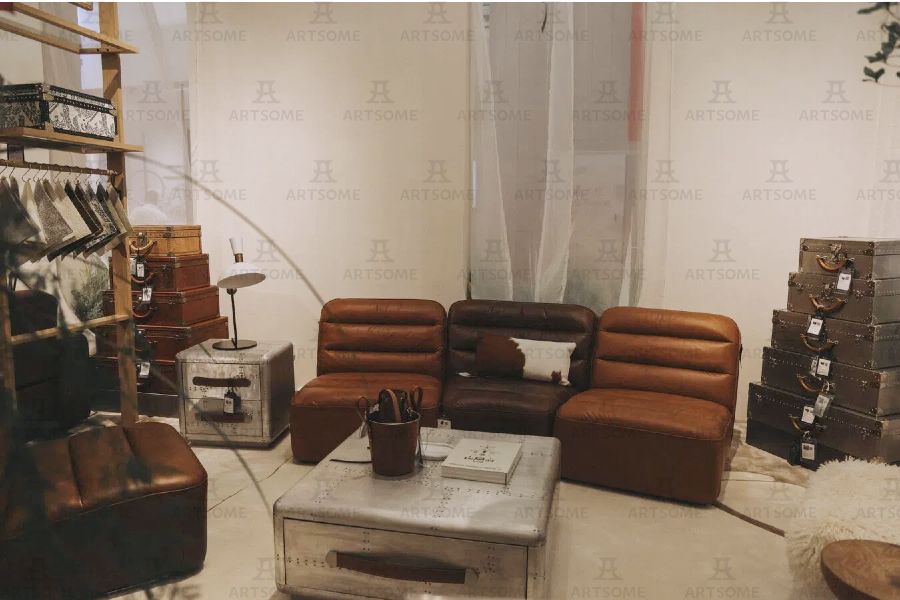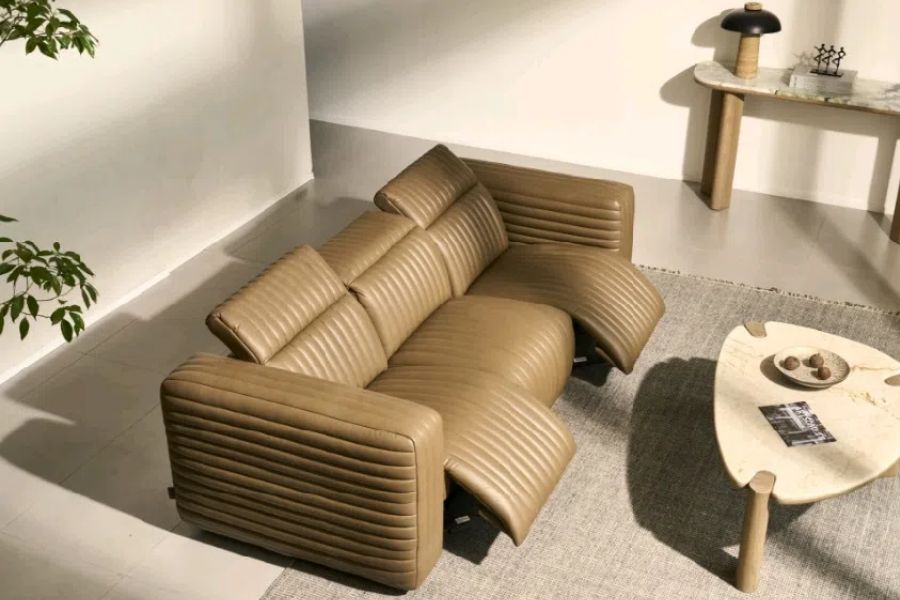
Introduction of Modern Furniture Material — Acrylic and Glass
- By:ARTSOME
- 2023-07-15
- 351
1. History of Acrylic and Glass
The appearance and use of glass in human life has a history of more than 4,000 years. The world’s first glass makers were the ancient Egyptians, who had developed relatively sophisticated glass-making techniques at that time. In the 12th century, commercial glass appeared and began to become an industrial material. In the 18th century, optical glass was made to suit the needs of telescopes. Plate glass was first made in Belgium in 1874. Since then, with the industrialization and scale of glass production, various uses and properties of glass have been published. Nowadays, glass has become an important material in daily life, production and science and technology.
With the progress of science and technology, a new type of glass, tempered glass has been produced. The development of tempered glass originally dates back to the mid-17th century. The first patent for glass tempering was obtained by the French in 1874. Tempered glass is made of plate glass heated to nearly glass transition temperature, and cooled immediately and rapidly to raise surface stress. This method is the early liquid tempering method.
In the 1930s, in order to meet the demand of production activities, the world began the era of mass production of tempered glass. Since the 1970s, tempered glass technology has been comprehensively promoted and popularized worldwide. Tempered glass has been used in automobile, construction, aviation, electronics and other fields, such as furniture.
Acrylic is much older than people usually think. And also, acrylic lasts longer than is usually expected! Acrylic is a broad array of synthetic resins and fibers that are based on derivatives of acrylic and methacrylic acid. Both acrylic acid and methacrylic acid have been created in the mid-19th century, looking to create a safety glass, but the practical potential of materials related to these compounds became apparent only about 1901, when German chemist Otto Röhm published doctoral research on polymers of acrylic esters. Acrylic became commercially available by 1937, used in jewelry, handbags, cosmetics packaging. During World War II, tensions between nations and the resulting shortage of raw materials boosted the demand for acrylic glass. For example, acrylic was common in use for military applications, such as airplane windshields, submarine periscopes.
After the war, the volume of use of acrylic was greatly declined. Manufacturers needed to find non-military uses for acrylic, so they licensed it widely. The development that was started now concerned other applications and therefore other designs, with color and diffusion. Applications were protective covers for street lighting, fluorescent lighting and also a lot of illuminated advertising bins. Increasingly larger sizes of sheets and blocks were also being requested from the market for protection, roof panels, and furniture. In 1941, acrylic was first used in furniture in Germany. At that time, an arts and crafts designer suddenly thought, if can use acrylic to make furniture it must be a perfect thing. So he designed an acrylic based tea table, and three days later it was produced. So far acrylic furniture was born. And by the 1960s it was often found in furniture. In 21st century, acrylic furniture has achieved considerable development. In many high-end hotels, villas, we can see acrylic furniture in the field of home decoration interpretation of the classic aesthetic.
2. Characteristics of Tempered Glass and Acrylic
Glass is an inorganic solid material that is usually transparent or translucent as well as hard, brittle, and impervious to the natural elements. Qinhuangdao, Luoyang, Shanghai, Shekou (Shenzhen) are main glass production areas in China. Artsome’s furniture is made of glass raw materials from Shekou, Shenzhen, where the glass is of the best quality. Glass colors are commonly green, blue, gray, purple, black or colorless. According to the surface state can be divided into plate glass, embossed glass, polished glass, float glass, etc. Plate glass is made from silica, sea sand and other petroleum refined at high temperature. Float glass is made by pouring the molten glass from a furnace into a chamber that contains a bed of molten tin. The atmosphere inside the chamber is carefully controlled. The glass floats on the tin and forms itself in the shape of the container. It is more substantial and transparent than plate glass, for it is treated and cured in an oven to gain strength and durability.
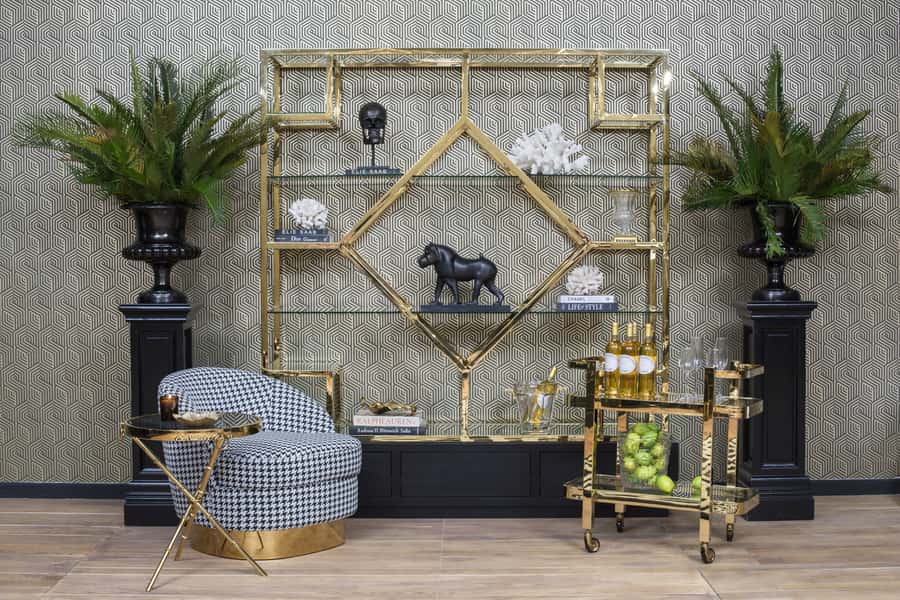
Tempered glass is also known as safety glass. It’s similar to the molten tin process in normal float glass. The difference is that tempered glass goes through an additional thermal tempering process to harden it. It can resist more pressure than ordinary glass up to 30-40 kilograms and has a good impact resistant. Even if it is broken by strong external force, it will not form sharp edges and corners like ordinary glass. Tempered glass will form granular crystals without edges and corners after being broken, so it is called as safety glass. Artsome’s glass is all tempered glass that has been treated at high temperatures.
- Advantages of Tempered Glass
1. Crystal clear.
2. Stable used in larger constructions.
3. Heat resistant.
4. Resistant to temperature changes.
5. Anti-microbial.
6. Less easily scratched.
7. Resistant to sunlight and UV rays.
- Disadvantages of Tempered Glass
1. The tempered glass can no longer be cut and processed.
2. When made with low-quality glass, it will have a scratched appearance.
3. Restricted in shape.
Acrylic is a transparent thermoplastic that is lightweight and shatter-resistant, making it an attractive alternative to glass. The acrylic is meticulously cut to shape for each individual piece of furniture, and the edges sanded completely smooth. Finished components are secured in place by hand with shiny steel screws or high strength professional adhesive which is carefully heated to dissolve into the acrylic, preventing any marks and ensuring a crystal clear finish that sparkles when the light catches it.
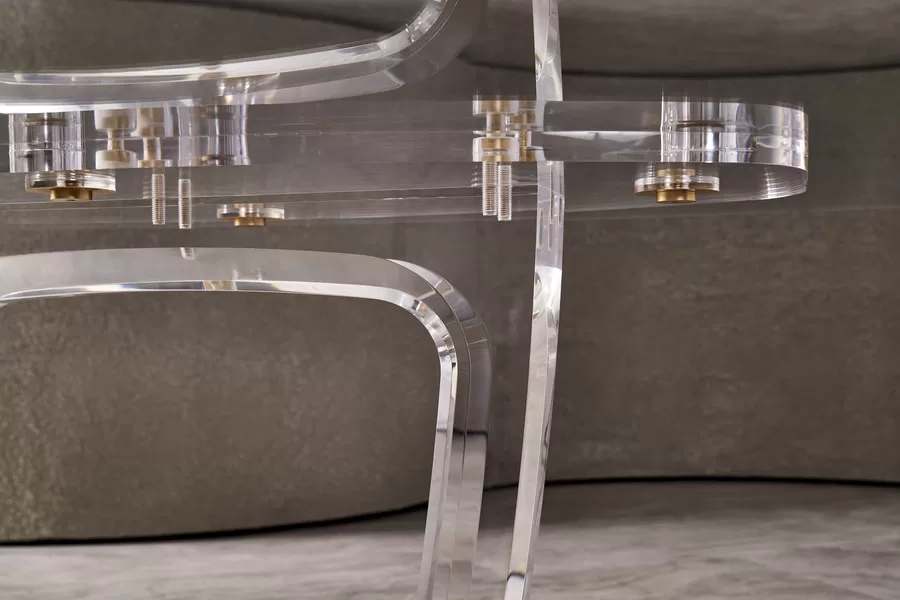
- Advantages of Acrylic
1. Stronger than standard glass.
2. Shatter-resistant.
3. Lightweight.
4. Available in a range of colors and textures.
5. Can be cut with circular saws and routers.
6. Can be attached to other pieces of acrylic using bolts, welds, or cement.
- Disadvantages of Acrylic
1. Easily scratched.
2. Solvents make crazing worse and ammonia and ammonia-based cleaners cause it to become cloudy.
3. Burning it releases dangerous fumes.
4. It has visible distortion, for it was etched, laminated, back-painted, or printed.
3. The Application in Furniture
Acrylic and tempered glass, both strong and transparent, have similar uses in nature. While there are obvious differences, both types of glass are resistant to fractures, cracks, and splinters caused by stress or impact. In the series of metal dining tables, side tables and metal frame shelves, Artsome tempered glass will be used as the table top. And acrylic is use as table legs and chair legs.
Most of the living space will be designed to combine the dining room and kitchen in order to save space. And people will also pay attention to select small and light type of dinning furniture. As shown in the picture below, this Dining Chair Chandigarh is made of classic cow leather cushion and acrylic feet, which is the neat design of V-shaped with a light luster. Acrylic chair legs represent modern style and unique character. Wherever it goes, it will be the focus.
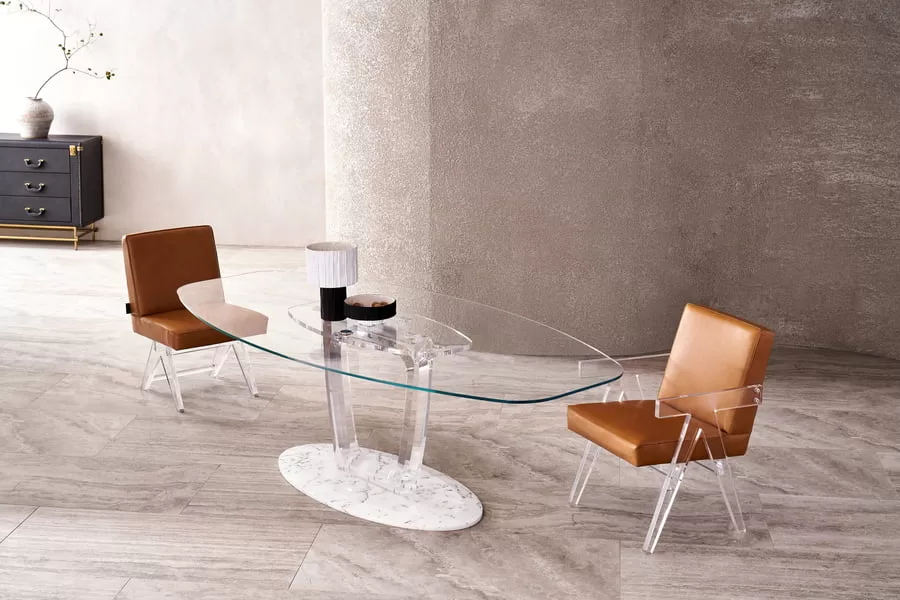
Tempered glass is heavier than acrylic but it’s much more resistant to scratches. With this in mind, a coffee table, side table, or dining table that features an acrylic base with a tempered glass tabletop will give you the best combination of functionality and durability. The visual combination of virtual and real, concise and modern makes the space more transparent. It fully demonstrates the close connection between the classic and the future, creating a new and interesting concept. With the combination of cow leather with long-standing culture and acrylic materials, Artsome high end home furniture embodies the materials incisively and vividly.
There is another representation of acrylic. Trunk Gaga is made of brushed gold stainless steel and acrylic, inlaid with copper nails for decoration. It can be placed as a side table or as a display case with some handcrafts or garage kit inside it.
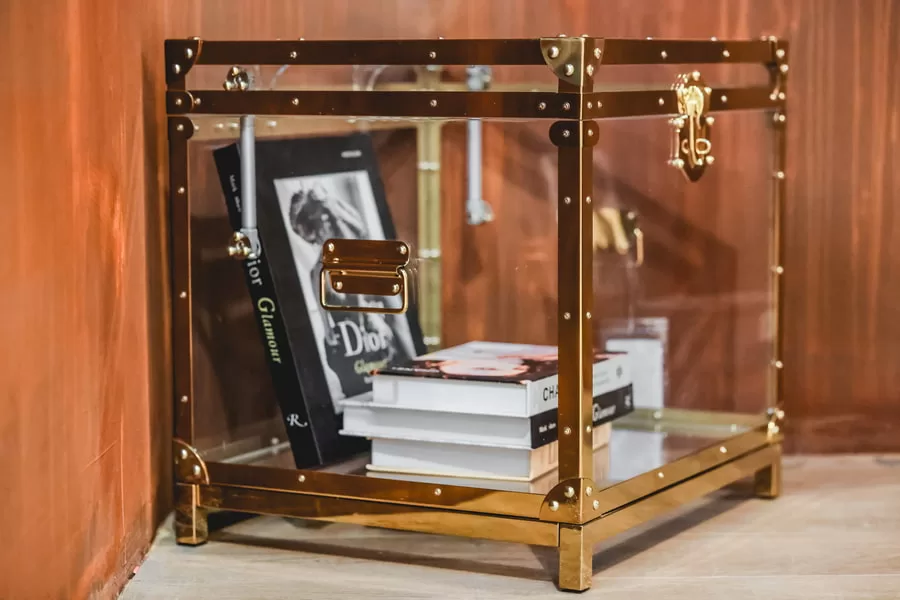
- When to Use Acrylic
1. If you’re cleaning crews and know how to maintain it.
2. If you’re okay with some visual abnormalities.
3. If you need to reduce the risk of breakage.
4. If you’re often replacing the panels due to remodels or updates.
5. Much lighter.
- When to Use Glass
1. High traffic areas when you need durability.
2. Scratch resistant.
3. Daylighting an environment.
4. When you need UV protection on the cheap.
5. When you can’t worry about maintenance.
6. When a clean environment is a must.
7. When visual perfection is a must.
4.General Care and Maintenance
4.1 Acrylic
- Acrylic is synthetic material and can be easily scratched or marked. Try to avoid placing sharp or abrasive objects on its surface.
- Protect your table top from hot, wet or abrasive objects by using coasters, trivets and placemats.
- Ensure your furniture is not too close to a heat source or in direct sunlight or moonlight for long periods.
- Certain solvents can damage acrylic, it is best to keep your furniture away from harsh chemicals.
- To clean your furniture, use a clean, soft cloth dampened with a solution of mild detergent and water. Blot dry using a clean soft cloth.
- Acrylic should not be kept in a wet environment such as a bathroom or kitchen, as the moisture may cause the acrylic to crack.
4.2 Tempered Glass
- Protect your glass table top from hot, wet or abrasive objects by using coasters, trivets and placemats.
- Wipe up spills immediately.
- Clean regularly using glass cleaner or a soft, slightly damp chamois. Wipe dry.
- Avoid the use of chemical and abrasive cleaners, steel wool or scouring pads, as these may damage the glass.
- Be gentle during the transportation. Its edge, angle and other sharp places are most likely to be damaged, don’t let them collide with the wall.
-
The New Aviation Series: Weaving a Narrative of Sky and Earth in Contemporary Bar Design
2025-11-12 -
The Chaise Longue: A Journey Through Time and Design – Featuring ARTSOME’s New Collection
2025-10-17 -
The Exhibition – Canton Fair 2025 (October)
2025-09-30 -
The New Terraced Sofa Series: Where Ancient Landscapes Meet Modern Comfort
2025-08-29 -
The Exhibition – Furniture China 2025 Shanghai
2025-08-05 -
They produce thousands a day? We brew three legends in 30 years!
2025-08-02 -
ARTSOME LEATHER
2025-07-17 -
Timeless Craftsmanship, Since 1995
2025-07-02 -
Full-Length Mirrors & Hanging Mirrors With Leather Edge: Functional Elegance for Modern Living
2025-06-16 -
Corlandus Leather Armchair
2025-05-29
-
Egg Chair & Swan Chair, the Iconic Symbol of Scandinavian Design
2023-11-13 -
Vanity Fair Sofa, the Luxurious and Stylish Furniture
2023-10-04 -
A Guide for Modern Metal Furniture
2023-08-15 -
Introduction of Modern Furniture Material — Acrylic and Glass
2023-07-15 -
The Structure & Materials of Artsome Leather Sofa
2022-12-16 -
Modern Furniture Finishes & Furniture Care Tips
2022-11-14 -
How to Design the Modern Furniture Sofa
2022-10-02 -
Tips for Looking for a Quality New Bed
2022-09-13 -
Tips for Mid-Century Modern Furniture Placement
2022-08-19 -
Types & Identifying Tips of Cowhide Leather
2022-08-06




